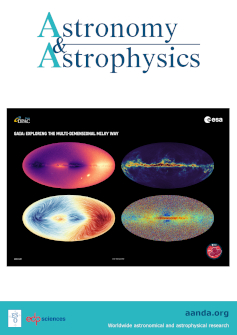Confronting sparse Gaia DR3 photometry with TESS for a sample of around 60 000 OBAF-type pulsators★★★
IF 5.4
2区 物理与天体物理
Q1 ASTRONOMY & ASTROPHYSICS
引用次数: 0
Abstract
Context. The Gaia mission has delivered hundreds of thousands of variable star light curves in multiple wavelengths. Recent work demonstrates that these light curves can be used to identify (non-)radial pulsations in OBAF-type stars, despite their irregular cadence and low light curve precision, of the order of a few millimagnitudes. With the considerably more precise TESS photometry, we revisited these candidate pulsators to conclusively ascertain the nature of their variability.Aims. We seek to re-classify the Gaia light curves with the first two years of TESS photometry for a sample of 58 970 p- and g-mode pulsators, encompassing γ Dor, δ Scuti, slowly pulsating B, and β Cep variables. From the TESS data, we seek to assess the quality of Gaia’s classification of non-radial pulsators, which is based on sparse, years-long light curves of millimagnitude precision. We also supply four new catalogues containing the confirmed pulsators, along with their dominant and secondary pulsation frequencies, the number of independent mode frequencies, and a ranking according to their usefulness for future asteroseismic ensemble analysis.Methods. We first analysed the TESS light curves independent of their Gaia classification by pre-whitening all dominant pulsation modes down to a 1% false alarm probability. Using this, in combination with a feature-based random forest classifier, we identified different variability types across the sample.Results. We find that the Gaia photometry is exceptionally accurate for detecting the dominant and secondary frequencies, reaching approximately 80% accuracy in frequency for p- and g-mode pulsators. The majority of Gaia classifications are consistent with the classifications from the TESS data, illustrating the power of the low-cadence Gaia photometry for pulsation studies. We find that the sample of g-mode pulsators forms a continuous group of variable stars along the main sequence across B, A, and F spectral types, implying that the mode excitation mechanisms for all these pulsators need to be updated with improved physics. Finally, we provide a rank-ordered table of pulsators according to their asteroseismic potential for follow-up studies, based on the number of sectors they have been observed in, their classification probability, and the number of independent modes found in the TESS light curves from the nominal mission.Conclusions. Our catalogue offers a major increase in the number of confirmed g-mode pulsators with an identified dominant mode suitable for follow-up TESS ensemble asteroseismology of such stars.用 TESS 对大约 60 000 个 OBAF 型脉冲星样本进行稀疏盖亚 DR3 光度测量★★★★
背景盖亚任务提供了数十万条多波长变星光曲线。最近的研究表明,这些光曲线可以用来识别 OBAF 型恒星的(非)径向脉动,尽管它们的周期不规则,光曲线的精度也很低,只有几毫微米的数量级。有了更为精确的 TESS 光度计,我们重新研究了这些候选脉冲星,以最终确定它们的变率性质。我们试图用前两年的 TESS 测光数据对 58 970 个 p 模式和 g 模式脉冲星样本的 Gaia 光曲线进行重新分类,其中包括 γ Dor、δ Scuti、慢脉冲 B 和 β Cep 变量。根据 TESS 数据,我们试图评估 Gaia 对非径向脉动器分类的质量,该分类是基于稀疏的、长达数年的、精度为毫磁级的光变曲线。我们还提供了四个新的目录,其中包含已确认的脉冲星,以及它们的主要和次要脉冲频率、独立模式频率的数量,并根据它们对未来小行星地震集合分析的有用性进行了排序。我们首先分析了独立于盖亚分类的 TESS 光曲线,将所有主要脉动模式预先白化到 1%的误报概率。利用这种方法,结合基于特征的随机森林分类器,我们确定了整个样本的不同变异类型。我们发现盖亚光度计在检测主频和副频方面异常准确,p 模和 g 模脉冲星的频率准确率达到约 80%。盖亚的大部分分类与 TESS 数据的分类一致,这说明盖亚的低信噪比光度测量在脉冲研究中的强大功能。我们发现,g模式脉冲星样本形成了一个连续的变星群,沿着主序分布在B、A和F光谱型中,这意味着所有这些脉冲星的模式激发机制都需要通过改进物理学来更新。最后,我们根据脉冲星被观测到的扇区数量、其分类概率以及在 TESS 名义任务光曲线中发现的独立模式数量,提供了一个脉冲星排序表,以根据它们的小行星地震潜力进行后续研究。我们的目录大大增加了已确认的 g 模式脉冲星的数量,这些脉冲星的主导模式已被确定,适合对这类恒星进行 TESS 组合小行星震后续研究。
本文章由计算机程序翻译,如有差异,请以英文原文为准。
求助全文
约1分钟内获得全文
求助全文
来源期刊

Astronomy & Astrophysics
地学天文-天文与天体物理
CiteScore
10.20
自引率
27.70%
发文量
2105
审稿时长
1-2 weeks
期刊介绍:
Astronomy & Astrophysics is an international Journal that publishes papers on all aspects of astronomy and astrophysics (theoretical, observational, and instrumental) independently of the techniques used to obtain the results.
文献相关原料
| 公司名称 | 产品信息 | 采购帮参考价格 |
|---|
 求助内容:
求助内容: 应助结果提醒方式:
应助结果提醒方式:


